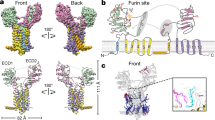Abstract
Hedgehog proteins use an auto-processing strategy to generate cholesterol-conjugated peptide products that act as extracellular ligands in a number of developmental signaling pathways. We describe an approach that takes advantage of the hedgehog auto-processing reaction to carry out intracellular modification of heterologous proteins, resulting in their localization to cell membranes. Such processing occurs spontaneously, without accessory proteins or modification by other enzymes. Using the green fluorescent protein (GFP) and the product of the Hras as model proteins, we demonstrate the use of hedgehog auto-processing to process heterologous N-terminal domains and direct the resulting biologically active products to cell membranes. This system represents a tool for targeting functional peptides and proteins to cell membranes, and may also offer a means of directing peptides or other small molecules to components of cholesterol metabolism or regulation.
This is a preview of subscription content, access via your institution
Access options
Subscribe to this journal
Receive 12 print issues and online access
$209.00 per year
only $17.42 per issue
Buy this article
- Purchase on Springer Link
- Instant access to full article PDF
Prices may be subject to local taxes which are calculated during checkout



Similar content being viewed by others
References
Clarke, S. Protein isoprenylation and methylation at carboxyl-terminal cysteine residues. Annu. Rev. Biochem. 61, 355–386 (1992).
Rogers, W. Making membranes green: construction and characterization of GFP-fusion proteins targeted to discrete plasma membrane domains. Biotechniques 5, 1044–1046 (2002).
Zacharias, D., Violin, J., Newton, A. & Tsien, R. Partitioning of lipid-modified monomeric GFPs into membrane microdomains of live cells. Science 296, 913–916 (2002).
Porter, J.A., Young, K.E. & Beachy, P.A. Cholesterol modification of hedgehog signaling proteins in animal development. Science 274, 255–259 (1996).
Porter, J.A. et al. Hedgehog patterning activity: Role of lipophilic modification mediated by the carboxyl-terminal autoprocessing domain. Cell 86, 21–34 (1996).
Ingham, P.W. Hedgehog signaling: a tale of two lipids. Science 294, 1879–1881 (2001).
Casey, P.J., Solski, P.A., Der, C.J. & Buss, J.E. p21ras is modified by a farnesyl isoprenoid. Proc. Natl. Acad. Sci. USA 86, 8323–8627 (1989).
Bordier, C. Phase separation of integral membrane proteins in Triton X-114 solution. J. Biol. Chem. 256, 1604–1607 (1981).
Hall, T.M. et al. Crystal structure of a Hedgehog autoprocessing domain: homology between Hedgehog and self-splicing proteins. Cell 91, 85–97 (1997).
Smart, E.J. et al. Caveolins, liquid-ordered domains, and signal transduction. Mol. Cell. Biol. 19, 7289–7304 (1999).
Simons, K. & Toomre, D. Lipid rafts and signal transduction. Nat. Rev. Mol. Cell. Biol. 1, 31–39 (2000).
Simons, K. & Ikonen, E. How cells handle cholesterol. Science 290, 1721–1726 (2000).
Simons, K. & Ikonen, E. Functional rafts in cell membranes. Nature 387, 569–572 (1997).
Simons, K. & Ehehalt, R. Cholesterol, lipid rafts and diseases. J. Clin. Invest. 110, 597–603 (2002).
Song, K.S. et al. Co-purification and direct interaction of Ras with Caveolin, an integral membrane protein of caveolae microdomains. J. Biol. Chem. 271, 9690–9697 (1986).
Albritton, L.M., Tseng, L., Scadden, D. & Cunningham, J.M. A putative murine ecotropic retrovirus receptor gene encodes a multiple membrane-spanning protein and confers susceptibility to virus infection. Cell 57, 659–666 (1989).
Covic, L., Gresser, A.L., Talavera, J., Swift, S. & Kuliopulos, A. Activation and inhibition of G protein-coupled receptors by cell-penetrating membrane-tethered peptides. Proc. Natl. Acad. Sci. USA. 99, 643–648 (2002).
Brown, S.B. & Golstein, J.L. A proteolytic pathway that controls the cholesterol content of membranes, cells and blood. Proc. Natl. Acad. Sci. USA 96, 11041–11048 (1999).
Grand-Perret, T. et al. SCAP ligands are potent new lipid-lowering drugs. Nat. Med. 7, 1332–1338. (2001).
Hartmann, T. Cholesterol, Ab and Alzheimer's disease. Trends Neurosci. (Suppl.) 11 S45–S48 (2001).
Acknowledgements
The authors wish to thank Peter Erhardt of the Boston Biomedical Research Institute for use of the confocal microscopy facility.
Author information
Authors and Affiliations
Corresponding author
Ethics declarations
Competing interests
The authors declare no competing financial interests.
Supplementary information
Rights and permissions
About this article
Cite this article
Vincent, S., Thomas, A., Brasher, B. et al. Targeting of proteins to membranes through hedgehog auto-processing. Nat Biotechnol 21, 936–940 (2003). https://doi.org/10.1038/nbt844
Received:
Accepted:
Published:
Issue Date:
DOI: https://doi.org/10.1038/nbt844
This article is cited by
-
Specialized filopodia direct long-range transport of SHH during vertebrate tissue patterning
Nature (2013)
-
Semisynthesis of a Protein with Cholesterol at the C-Terminal, Targeted to the Cell Membrane of Live Cells
The Protein Journal (2010)
-
The Role of Sonic Hedgehog Reemergence During Gastric Cancer
Digestive Diseases and Sciences (2010)
-
Sonic hedgehog ligand partners with caveolin-1 for intracellular transport
Laboratory Investigation (2009)



